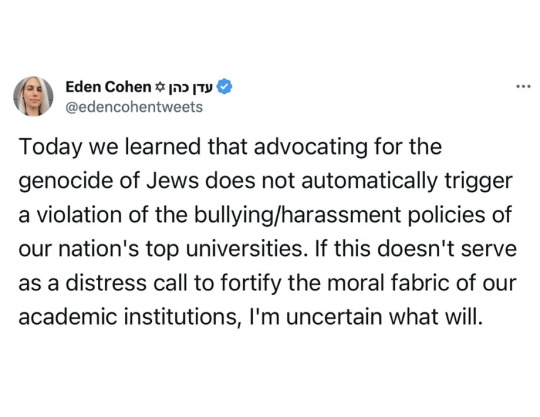#MIT
Text
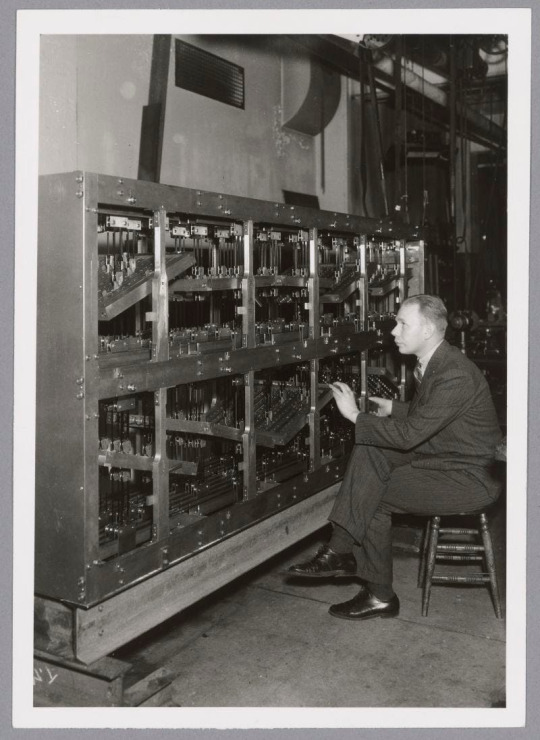
My great grandfather “Bud” Wilbur gave his son Jack an Erector Set one Christmas then took it back the same day. The Erector Set was a children’s toy made of metal pieces that allowed kids to build various model structures like bridges and poorly made bridges. Before video games, children had very few choices for entertainment: marbles, Erector Sets, or becoming a Peeping Tom. Those were the choices. My grandpa Jack was going to be an engineer like his father, and to seal his fate, great grandpa Bud bought him the tools to try his hand at building. Bud, seeing the pieces scattered on the floor must have thought “pearls before swine” while having his eureka moment. Using the toy he had bought his son, he built a model of what he called The Simultaneous Calculator, what the American papers in 1937 called “Robot-Einstein,” and what the Japanese dubbed “The Wilbur Machine.”
He didn’t build the first calculator. I believe that honor technically belongs to the Mesopotamians who made the first abacus. Nor did the calculator conceptually resemble the digital computing systems we have now that employ ones and zeros and a lot of electricity. The Wilbur Machine was an analog computing system with pulleys and brass bars that solved 9 equations simultaneously (or 9x9 systems according to an MIT grad’s thesis that I can only comprehend up to page 4). Math equations that once took a full day to solve now took roughly 1-3 hours. It sped up the production of large structures, power grids, and for one country it seems, planes. It was a big advancement in 1936-37, an advancement that was eclipsed by better smaller machines soon after. In the United States, that is. In Japan, a 3x3 system Wilbur Machine was replicated in the late 30s and a fully functioning 9x9 calculator was completed in 1944 at the Tokyo Imperial University’s Aviation Laboratory.
You read that correctly. My great-grandfather Bud Wilbur built a machine that was stolen by an Axis power right before World War II. Japan continued to use the machine until the war’s end. So, uh…sorry about that? It wasn’t Bud’s intention.
Read the rest of the essay here.
#essays#essay#writing#reading#personal essay#Japan#interesting#travel#science#math#MIT#Wilbur machine#dan wilbur#long reads#movies#family
22 notes
·
View notes
Text

Chris Williams
Born in New York City, Chris Williams considers Potomac, Maryland, to be his hometown. A private pilot and Eagle Scout, Williams is a board-certified medical physicist and holds a doctorate in physics from MIT. https://go.nasa.gov/49YJJmf
Make sure to follow us on Tumblr for your regular dose of space!
#NASA#astronaut#NASA Yearbook#graduation#Class of 2024#space#Inspiration#Maryland#Eagle Scout#physics#MIT#STEM
2K notes
·
View notes
Text

Parrots learn to make video calls to chat with other parrots, then develop friendships with each other
Researchers from Northeastern University, in conjunction with scientists from MIT and the University of Glasgow, conducted a study exploring the impact of teaching a group of domesticated birds to communicate using tablets and smartphones. The findings indicate that utilizing video calls may assist parrots in mimicking the communication patterns observed in wild birds, potentially enhancing their behavior and overall well-being in the homes of their owners.
via smithsonianmag.com
#parrot#mit#northeastern university#university of glasgow#study#animals#technology#video call#wild birds#TechForPets#Animal research#animal behavior
2K notes
·
View notes
Text
Free MIT online courses that sound interesting
Arts & Literature
Introduction to World Music
Reading Fiction
Literary Interpretation: Virginia Woolf's Shakespeare
Introduction to Photography
Foundations of Western Culture II: Renaissance to Modernity
Studies in Poetry - Briths Poetry and the Sciences of the Mind
Studies in Literary History: Modernism: From Nietzsche to Fellini
Screen Women: Body Narratives in Popular American Film
Studies in Poetry: "What's the Use of Beauty"
Queer Cinema and Visual Culture
Monteverdi to Mozart: 1600 - 1800
Writing and Experience: Reading and Writing Autobiography
Advanced Topics in Hispanic Literature and Film: The Films of Luis Buñel
Major Authors: Rewriting Genesis: "Paradise Lost" and Twentieth-Century Fantasy
Arthurian Literature and Celtic Colonization
Contemporary Literature: Britsh Novel Now
Studies in Poetry: 20th Century Irish Poetry: The Shadow of W. B. Yeats
Writing About Literature: Writing About Love
Introduction to European and Latin American Fiction: Great Books On The Page and On The Screen
Popular Culture and Narrative: Use and Abuse of the Fairy Tale
Victorian Literature and Culture
Reading Poetry
English Renaissance Drama: Theatre and Society in the Age of Shakespeare
Introduction to Fiction
International Woman's Voice
Major Authors: Oscar Wilde and the "90's"
Prizewinners: Nobelistas
American Authors: American Women Authors
Shakespeare, Film and Media
Japanese Literature and Cinema
Woman's Novels: A Weekly Book Club
Classics of Chinese Literature
Major English Novels
Topics in South Asia Literature and Culture
Introduction to Literary Theory
History & Social Studies
American Classics
The Middle East in the 20th Century
Africa and the Politics of Knowledge
The Rise of Modern Science
European Imperialism in the 19th and 20th Century
Philosophy of Love
Human Rights: At Home and Abroad
The Nature of Creativity
Introduction to Comparative Politics
Riots, Rebellions, Revolutions
Introduction to the History of Technology
Ancient Philosophy
Youth Political Participation
#studyblr#study resources#dark academia#light academia#chaotic academia#romantic academia#adhd academia#studyblr brazil#literature#art academia#mit#free courses#study#collegeblr#studyblr college
1K notes
·
View notes
Text
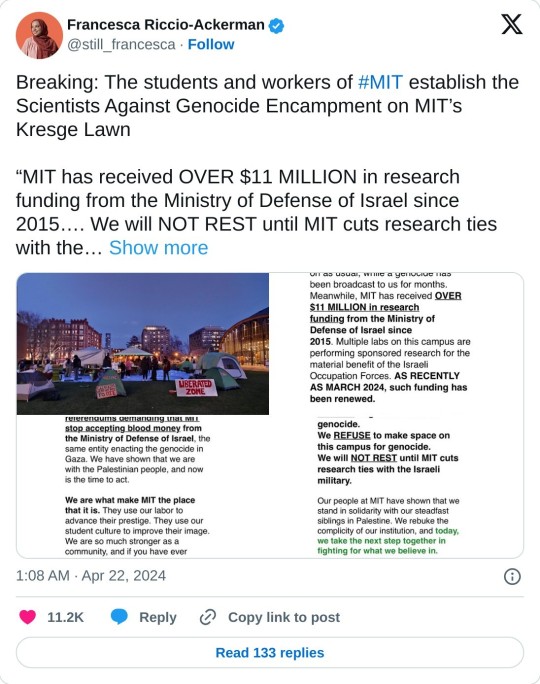





#yemen#jerusalem#tel aviv#current events#palestine#free palestine#gaza#free gaza#news on gaza#palestine news#news update#war news#war on gaza#mit#protests#anti zionism
279 notes
·
View notes
Text

In 1978 MIT CS students Danny Hillis and Brian Silverman designed a working computer capable of playing tic-tac-toe against a human opponent entirely out of Tinker Toys.
The machine consisted of 10,000 wooden parts and fishing line, and was designed with the help of a LISP program running on a DEC PDP-10.
In a letter to computer pioneer Gordon Bell describing the project, Hillis said the machine could have been built by any six-year-old with 500 sets of Tinker Toys, and a PDP-10.
307 notes
·
View notes
Text
I've got a question to someone more Mathematically Learned than me:
What is the current Edge Of Human Knowledge in regards to the origins and fundamentals of the natural world? What's the current thread that most people are trying to follow to get down to like. The exact reason for the nature of the universe? I've heard that in the first second directly after the big bang, things were quote "a little weird," unquote. And I want to know what that means. I'd like to know what gaps in our knowledge of physics we are most focused on trying to fill right now.
#text#random thought#physics#STEM#im just gonna tag people who might search for this shit#theoretical physics#conspiracy theories#uhh#NASA#MIT#fuckin uhhhhhhhhh uhh who else uhhhhh#nerds#science#learning#math#thats all i got#please help me smart people im academically helpless and need the strong embrace of your hot wet muscley brains :)
184 notes
·
View notes
Text
Beziehung für immer kann es nur geben, wenn man in der Zeit der Wegwerfgesellschaft den Mut zum reparieren hat.
#eigenes#herzschmerz#trennung#liebe#verliebt#verletzt#schmerz#vermissen#enttäuscht#sloth#mit#glücklich#verloren#einsam#reparieren
454 notes
·
View notes
Text
i learned that the smoot is a unit of measure named for Oliver R. Smoot, an MIT student who as a fraternity pledge was forced to measure the Harvard Bridge using himself as a ruler. A smoot is equal to five feet, seven inches. (x)
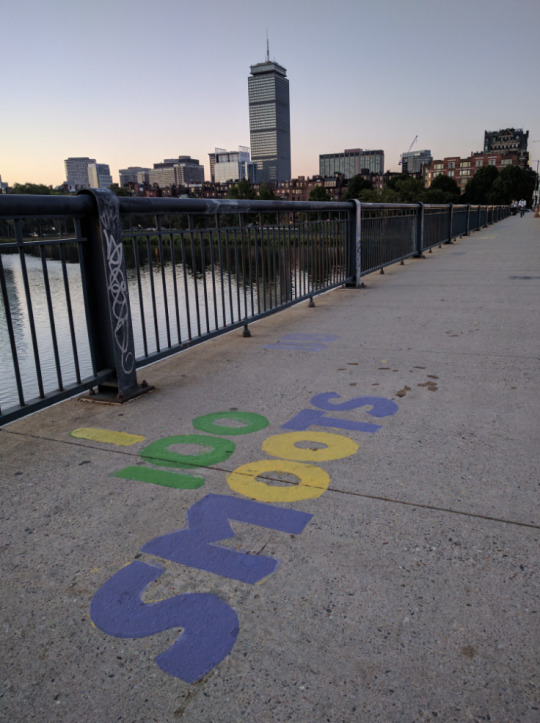
341 notes
·
View notes
Link
“When it comes to explaining Roman engineering, people looking to demonstrate their genius have a variety of use cases, but the secret to why their concrete has remained when even modern buildings crumble after just a few years of disuse has eluded scientists.
However at MIT, scientists have cracked their concrete code to show that Roman concrete was self-repairing—it could naturally close cracks in as little as 2 weeks...
Indeed, the Romans did things with concrete that modern societies haven’t—just look at the Pantheon in Rome which still has the world’s largest unreinforced concrete dome. Aqueducts built to water the city literally still do, 2,000 years and sometimes more after they were built.
It was once assumed that lime was added to concrete with water to create a paste in a process called slaking, but by using spectroscopic imaging, Masic and his colleagues at MIT, and elsewhere in Switzerland and Italy, have determined that the Romans heated the lime ash to high temperatures to create what is known today as “quicklime.”
“The benefits of hot mixing are twofold,” Masic says. “First, when the overall concrete is heated to high temperatures, it allows chemistries that are not possible if you only used slaked lime, producing high-temperature-associated compounds that would not otherwise form. Second, this increased temperature significantly reduces curing and setting times since all the reactions are accelerated, allowing for much faster construction.”
In such concrete as this, cracks that form allow the easy travel of the lime clasts into open space which, when coming in contact with water, seal and close the cracks. The team mixed their own Roman concrete and it took only 2 weeks for a deliberately inflicted crack to close.
By contrast a contemporary concrete block was made without quicklime and it never repaired itself.
As a result, the team are working to commercialize this as self-healing Roman concrete in order to reduce the 8% of global emissions attributed to the manufacture and laying of concrete in cities.” -via Good News Network, 1/9/23
778 notes
·
View notes
Text
for months, MIT has been punishing students who speak up or protest for palestine. last week, the undergrad association held a referendum to establish solidarity with pro-palestinian activists on campus, to call for a ceasefire, and to tell the administration to sever ties with israel.
over 40% of undergraduates voted, and the referendum passed!
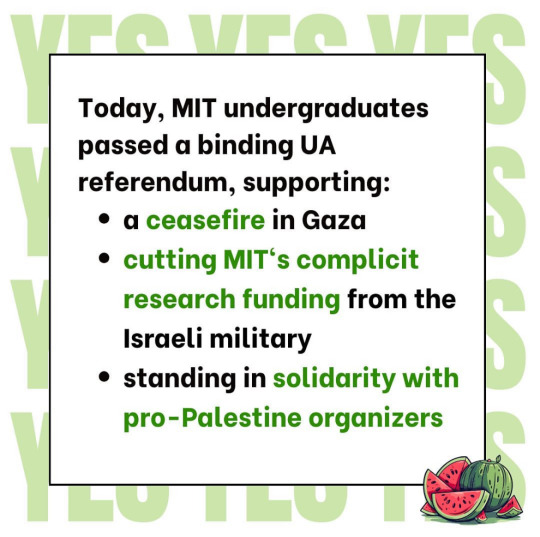

(you can read the text of the referendum here)
#txt#palestine#mit#massachusetts institute of technology#🇵🇸🇵🇸🇵🇸🇵🇸🇵🇸#id in alt text#edited to add a link to the instagram pos#t
54 notes
·
View notes
Text
Q-Does Gay's resignation mark the end of DEI?A-No because Harvard is a cesspool.



#Harvard#U Penn#MIT#DEI#vivek ramaswamy#Diversity#Affirmative Action#Eise Stefanik#USA#Claudine Gay#plagerism
55 notes
·
View notes
Text
"Last week, the presidents of Harvard, MIT, and the University of Pennsylvania were called to testify before Congress about the alarming rise of anti-Semitism on their campuses, and their tepid responses to it, in the wake of October 7.
By now, you have probably heard about the trio’s horrendous overall performance, punctuated by their smug inability to respond to the simple question of whether calling for the genocide of Jews violates their schools’ codes of conduct. Since that time, the president of UPenn has stepped down, and support for the other two is wavering.
In case you are wondering, their answer should have been an unequivocal “yes, it violates our polices.” The right to free speech is fundamental, but it does have limits: The First Amendment is not a pass to threaten, harass, intimidate or otherwise violate the rights of others.
For the record, even those pundits who (incorrectly) defended the university presidents’ testimony as being legally correct, if morally tone deaf, had to admit that it did represent a glaring double standard. Each of these universities has in recent years protected other minority groups from even “micro-aggressions” by effectively and ruthlessly shutting down speech that their leaders find offensive.
Struggling to answer whether calls for genocide against Jews constitutes bullying, after you have already officially labeled “fatphobia” as “violence” and “using the wrong pronoun” as a form of “abuse,” is pathetic, and to see these schools pretending that they are genuinely concerned about free speech all of a sudden is nothing short of laughable. In the Foundation for Individual Rights and Expression’s 2024 College Free Speech Rankings, for example, out of 248 US campuses, Penn and Harvard were ranked 247th and 248th, respectively. If you are only concerned about shutting down speech when that speech targets Jews, well, there is a word for that.
How Free Is Free Speech?
The First Amendment does not protect trespassing, vandalism, harassment, assault, or the destruction of property. Nor does it protect speech that is not meant to inform or persuade, but to disrupt lawful endeavors —activities like going to the kosher dining hall or studying in a library. The First Amendment does not protect someone who is making true threats, nor does it protect intimidation — “a type of true threat, where a speaker directs a threat to a person or group of persons with the intent of placing the victim in fear of bodily harm or death.”
Just a few months ago, in Counterman v. Colorado (2023), the United States Supreme Court clarified that this does not necessarily mean that the person speaking actually intended to threaten the victim. Rather, the Court imposed a recklessness standard — i.e., the First Amendment does not protect a person who consciously disregards a substantial risk that his communications would be viewed as threatening violence. To be clear, calling for the genocide of Jews, as the pro-Hamas student groups on campus have consistently been doing, does create a hostile environment for Jewish people on campus, violates Title VI of the Civil Rights Act of 1964, and is not protected by the First Amendment.
It was obvious that all three university presidents were reading off scripts written by their respective attorneys (several of whom were sitting behind them and nodding throughout the hearing). The question then becomes: What now? What is the critical error that their lawyers (and the general counsels at other universities where Jewish students are being targeted) have made in failing to stand up for Jewish people, and how should they immediately correct it?
The answer is simple, and it is exactly what students, parents, donors, and the government alike should all be demanding from these institutions: They should continue to respect the First Amendment, but they should apply the appropriate standard for speech on a campus.
From a legal perspective, it is easy to see where the university legal counsels’ confusion specifically arose. Those horrible answers were written under the assumption that the only limits a university can put on student speech are the limits contemplated in the foundational Supreme Court First Amendment case of Brandenburg v. Ohio (1969).
In that case, regarding speech at a KKK rally, the Court held that a state could only punish speech that “is directed to inciting or producing imminent lawless action and is likely to incite or produce such action.” Brandenburg is famously a very high standard, and that is precisely where the universities are hiding: Despite the hundreds of anecdotal incidents from the last two months, and notwithstanding all of the well-known studies confirming that inflammatory discriminatory anti-Semitic rhetoric leads directly to anti-Semitic violence, officials are telling students and parents and now Congress that their hands are tied because, in most cases, there has not been direct enough incitement.
Campus Standards Are Different
Now, the truth is that even under the Brandenburg standard, schools can still impose reasonable time, place, and manner restrictions. As the Court in Grayned v. City of Rockford (1972) explained: “The crucial question is whether the manner of expression is basically incompatible with the normal activity of a particular place at a particular time.”
So even under that paradigm, any activities that disrupt the educational enterprise and functioning of a school may be restricted. Common sense dictates that rallies celebrating calls for anti-Semitic genocide disrupt the educational enterprise and functioning of a school because they leave some students genuinely fearful for their lives.
But that argument is also unnecessary, because Brandenburg is absolutely the wrong standard for schools to be using, and university presidents and lawyers need to correct that mistake as soon as possible.
In Tinker v. Des Moines (1969), the Supreme Court explained that the Constitution does allow for schools to shut down speech that will “materially and substantially interfere” with the “requirements of appropriate discipline” in the operation of the school” or that “invad[es] the rights of others.” That is the standard that these schools must now vigilantly enforce.
Of course, private colleges and universities, like Harvard, Penn, and MIT, can restrict certain speech, conduct, and demonstrations, in most cases, without triggering any constitutional issues. But even a public university is not a public street, and the rules for what speech must be allowed on each are very different.
The Supreme Court in Healy v. James (1972) cited Tinker to hold that university officials do not have to tolerate student activities that breach reasonable campus rules; interrupt the educational process; or interfere with other students’ rights to receive an education. (This is especially true when the student speech is happening in school-sponsored forums, or is reasonably perceived as somehow bearing the school’s imprimatur.)
The Court has also repeatedly held (in Bethel v. Fraser [1986] and Hazelwood v. Kuhlmeier [1988]) that schools have even greater latitude to limit student expression if they can establish a “legitimate pedagogical concern.” Ensuring that all students — including Jewish students — have a safe and harassment-free environment in which to learn should be an overwhelmingly legitimate pedagogical concern.
Under the Tinker line of cases, schools do not even have to wait for a breach to actually occur; administrators can act if they can “reasonably forecast” that the expression in question would disrupt school discipline or operation, or violate the rights of other students. In Melton v. Young, for example, the Court ruled that schools could prohibit the wearing of a Confederate flag jacket because it was reasonable to assume that it would be disruptive in an environment of heightened racial tension.
Waving a Hamas flag and cheering on slaughter, as bodies are still being identified and hostages are still being held, announcing solidarity with the “resistance” and that “armed struggle” — i.e., murder —“is “legitimate,” and yes, calling for the genocide of Jews, are all behaviors that are no less likely to cause a disruption than a jacket.
Tinkering with Free Speech
Under Tinker, it is more than reasonable to forecast that there will be substantial disruptions that would violate the right of Jewish students to a non-hostile educational environment if groups are allowed to host events that glorify and celebrate the murder of Jews.
Schools can and must act now to prevent that from continuing to happen, using both common sense and the relevant case law to draw the appropriate line. The limits on the First Amendment are there to help the government with its primary responsibility —to protect all of its citizens from harm —and authorities must be constantly vigilant to enforce the law correctly.
Regardless, the answer to “what now?” then, is this: Everyone calling for change should articulate what that change is, and institutions fixing their policies should clearly explain how they will “tinker” with their free speech formulas so that the next time their leaders are asked if calling for a Jewish genocide is problematic, the answer can just be “yes.”
-Goldfeder, M. (2023g, December 13). Poison Ivies - Mishpacha Magazine. Mishpacha Magazine - The premier Magazine for the Jewish World. https://mishpacha.com/poison-ivies/
77 notes
·
View notes
Text
When Tony and Rhodey met each other

We know that they already knew each other in the spring of 1987 (IM1), right?
But for how long at that point? When did they actually meet?
While researching these questions, I discovered some inconsistencies and logical errors in the MCU.
It is known that Tony was born on May 29, 1970, and Rhodey on October 6, 1968. So Rhodey is 2 years older.
1984 - Tony went to MIT for his BS when he was 14 years old. Rhodey was 16.
We have information that Rhodey did not attend MIT for his Bachelor’s degree. He received it from the Air Force Academy and went to MIT for his Master’s degree. The minimum age for admission to the Air Force Academy is 17. Logic says that if Rhodey is not a genius like Tony, the appropriate age for him to start MS would be 20-21. But this would mean that he did not enter MIT until 1988. This is where the problems begin.
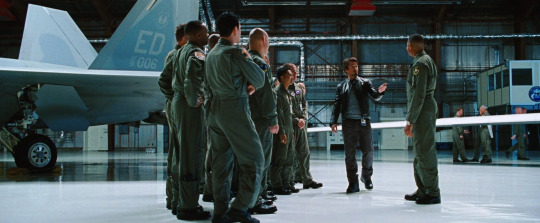
Spring Break 1987 (most likely March) - from what Tony said in the first Iron Man at 0:53:10, we have several interpretations:
Was it true?
a) One day, Rhodey woke up with a transgender/transvestite named Ivan in the same bed, and Tony witnessed or heard about it;
b) it was Tony’s joke and nothing happened, because Rhodey said “Don’t do that. They’ll believe that”.
Where were they?
1) They already knew each other. Rhodey was already studying at MIT. Logical error.
2) They didn’t know each other yet, but Rhodey was already at MIT getting his MS, meaning he started it at least in 1986 (18 years old). Logical error again.
3) They didn’t know each other yet and Rhodey was attending the Air Force Academy.
4) They knew each other because they met outside of MIT (maybe at some engineering competition, for example), and spent that spring break together.
1987 – Tony graduated from MIT. Graduation usually takes place in May.
What is 100% true we don’t know, because there is not enough information.
But the logical answer would be: at the time of spring break 1987, Tony was 16 and he was finishing his BS degree. Rhodey was 18 and he was still doing his BS at the Air Force Academy. At some point, they met and struck up a friendship. Then in 1988 or 1989, Rhodey went to MIT to get his master's degree at the same college as Tony because Tony was most likely getting his master's degree there at the time.
The movies never mention that Tony was getting a Master’s degree or actually received one, but there are enough hints to draw a conclusion, and I will do so in my next post.
46 notes
·
View notes
